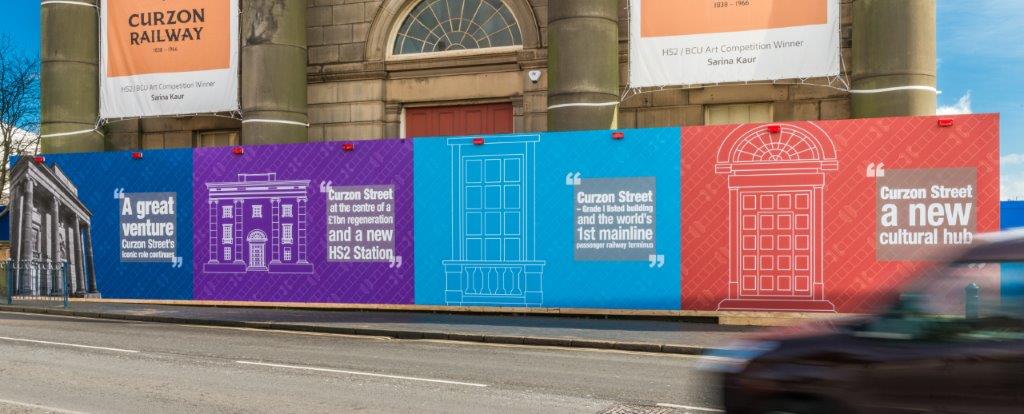Looking for some advice?
Despite the ongoing challenges presented by Covid19, we’re here to help. If you’re working on a large format project, and have any questions, please get in touch via our contact form – our expert project managers are on hand to answer any of your questions.
Although construction site hoardings are sometimes treated as a temporary, disposable part of the construction process, they represent a tremendous opportunity to positively engage nearby residents and boost the contractor’s reputation.
It is an unavoidable fact that initiating any building project automatically enters the construction company into a dialogue with the local community, whether the contractor takes ownership of the situation or not. Plain, undecorated hoardings may be functionally acceptable – but with extra care, these could be used to improve public relations, engage local residents and improve brand equity.
Giving a voice to the local community
Often construction works are seen as an imposition by the local residents, who may feel as though an unsolicited outside force has arrived to fill their environment with machinery, scaffolding, noise, and disruption. They are also likely to feel that there is nothing they can do about it – a situation likely to breed resentment and complaints.
By involving the neighbours in decisions on the design of the site hoardings, a contractor can give them some input in the process; it may be that they would be prepared to tolerate or react positively to the presence of the works in their environment if the hoarding graphics displayed something appealing, an image of local importance, or any other subject of their choice.
By initiating talks or forums with the town hall, local council, or even by polling residents on social media, a construction company can make the locals feel as though they are being listened to and erect hoardings that everybody agrees are more appropriate for the area.
Reducing potential delays and expenses
The majority of contractors work in a manner that is considerate of residents’ needs, attempting to keep noise, dust, and disruption to a minimum. However, if complaints do arise, it’s important to make sure that they don’t delay the work or cause too much unnecessary expense – and hoarding graphics have a part to play in this, too.
Sometimes, badly-judged or entirely undecorated and ugly hoardings can cause neighbours to complain, forcing a time-consuming and potentially expensive process of redesigning and reprinting the graphics – a situation that could have been avoided by speaking to the locals beforehand and asking for their input.
Early discussions can negate these kinds of problems, but to be on the safe side, you could even adopt a policy of approachability into the designs themselves. By using site hoardings to display contact details, a construction company can invite potentially unhappy locals to speak with the site manager or head office to resolve the issue directly and discreetly – and not leave them to complain to the council or local press.
Conveying the nature of the project
Construction projects are sometimes undertaken without much communication to the neighbours as to what is actually being built; often, it’s not always easy for residents in proximity to the site to become aware of the planning stages of a project (aside from the standard planning applications and notices), and are thus expected to tolerate building works in their environment despite having no idea what is happening.
Hoardings, then, are a great opportunity to very clearly illustrate how the local community can expect the finished work to look – and sometimes ideas that may not sound too appealing on paper can be made more palatable by visualising the idea with some artwork to show that the proposed building could look very attractive when completed.
Hoardings can in some circumstances also be used to generate interest for the client’s business; in the case of a block of flats, appealing promotional artwork around the building site could prime the local community to be excited about the new residential opportunities and to make enquiries – improving the standing of the contractor in the eyes of both the local inhabitants and the client.
Mitigating controversy
Sometimes, regrettably, a construction contract may come with a pre-existing dispute – perhaps the local community is unhappy about their tax money being deployed on a project they don’t believe to be a priority, or there might be disagreement about the environmental impact of the building work in a particular location.
Even though these issues may have been under discussion long before the construction company arrives to begin their work, it may well be the contractor who bears the brunt of much of the local displeasure.
The site hoardings, however, are an opportunity to diminish potential ill-feeling and communicate with positive messaging. The printed designs on the hoardings could explain the beneficial impact of the work being undertaken for the local community, and emphasise the contractor’s dedication to cultural sensitivity and environmental protection. In other words, a construction company can show that they have been listening.
In a sense, the hoardings of a building site are the “face” of a contractor; where the plans, contracts, and the construction work itself are often obfuscated from public view, the site hoardings are the one thing prominently on show for all to see – so why present a blank board?
Overall, hoarding graphics represent a tremendous opportunity to increase brand awareness and equity. In time, a construction company can build an emotional association that their business cares about the communities in which it works, listens to the concerns of residents and is invested in the future of local people.





